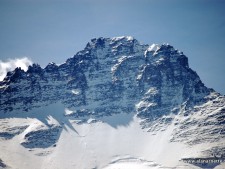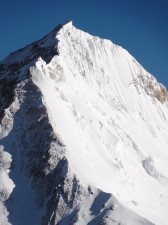
The 2014 teams heading towards base camp are not all going to climb Everest, in fact many, I would guess 10% are targeting Lhotse.
But before we discuss the world’s 4th highest peak at 27,940 feet or 8516 meters, let’s see what is going on right now. First off, there was a wedding at EBC as reported by IMG:
IMG guide Mike Hamill reports that team members Loretta and Jim were married at Everest base camp today. They have been together for 10 years, and today was the perfect occasion to tie the knot. Jim is staying to climb Mt. Everest with the team, and Loretta leaves tomorrow to start the trek back to Kathmandu. A huge congratulations to the happy couple on their special day.
So that is kind of tough to follow but elsewhere, more teams are streaming towards base camp and those who suffered flight delays seem to have gotten it all sorted for now. Those still en-route could be summed up in this post from Adventure Consultants:
Not much to report, but a had a great day resting in Pheriche. Some went for a walk while most chose to relax, do some email, have a shower, eat lots and read books. More tomorrow as we climb higher. All good here…
The teams climbing Cho Oyu or Everest from Tibet are preparing to cross the border tomorrow.
Lhotse
You will read about the “Lhotse Face” throughout this season as it a difficult section leading to the Death Zone at 8,000 meters. Obviously, the Face is part of Lhotse Peak, the west face to be precise. The route to Everest and Lhotse follows the same path from Everest Base Camp to the Yellow Band. There it diverges going straight up to the Lhotse High Camp and on to the summit.
It is half the cost of an Everest climb but takes about the same amount of time. Many who have climbed both consider it harder, or at least more technical than Everest. The summit push is shorter than on Everest. Lhotse involves some serious rock climbing with deadly rock fall danger. The final climb to the main summit of Lhotse is through a 500 foot narrow gully that often sheds rocks, large and small.
According to the Himalayan Database, there have been 600 summits with 435 of those without supplemental oxygen. Women represent 43 summits and Sherpas have 171 of the total summits.
But I expect this to change dramatically as many operators are now bundling Everest and Lhotse as a 2fer. Also, many previous Everest summiters are returning to climb Lhotse. The Altitude Junkies team has six Lhotse climbers and Himex has three.

On my 2011 climb, I spent a lot of time with Simon who was climbing Lhotse. We often discussed why he was spending 99% of the same time to snag the “lesser” peak.
He was consistent in his answer, I want to summit without crowds. That is a common profile of Lhotse climbers. He also was under no illusion that it was easier, or harder, than Everest – it was what it was.
We climbed together and left Camp 3, both on supplemental oxygen, on the Lhotse Face about the same time. I went on to the South Col and Simon turned right, up the very steep face towards Lhotse’s summit and their High Camp. He gave me an update once we both had returned safely to Base Camp.
It was harder than he expected, steep, icy, dangerous. He climbed slowly and carefully and had a great time! Simon was very satisfied with his climb and enjoyed the views of Everest! In fact he took a picture of Everest from the summit of Lhotse that showed me somewhere on my summit bid.

We compared technical difficulty. I felt the snowless Southeast Ridge Slabs were challenging with crampons against rock. He felt the large boulders and sometimes snow-free rock features of the gully were challenging. I felt the altitude and exposure to the fierce east winds were problematic. He felt the summit exposure was unsettling.
He also spoke of his crowds. Going up he was behind a group that accidentally kicked rocks dangerous towards them, not uncommon. With Lhotse’s new fame, it seems the crowd factor is shared between the two mountains We both admired the light from each other’s headlamp going higher on the other peak as we went higher on our own.
IMG guide Greg Vernovage describes Lhotse this way
Lhotse has some hazard of rock and ice and limited areas for resting. The sustained angle from Camp 4 on Lhotse (7850m) is a challenge. Always looking for foot placement and finding a safe place to rest makes it difficult to get into a rhythm. Walls on either side with loose rock and ice keep you on your toes. The kicker for Lhotse is the last 150 meters, which is the steepest part of the climb. You’ll need to use both your hands and feet to get to the summit, which seats only four of us at a time.
In a “normal” year, the summit day route on Lhotse is direct, technical, and exposed. Consistently steep, and mostly on firm snow, ice, and occasional rock, the route doesn’t have a single true flat spot where you can relax from Camp 4 all the way to the summit. This consistent climbing difficulty is combined with much lower-quality rope fixing and anchors, especially in the upper couloir and summit pyramid where the rock is low-quality. Climbers must be much more reliant on their climbing skills verses the ropes for their safety on the way up and down the route.Occasionally the couloir blows in with stable snow, and this is what makes it a possible ski line that many of us have dreamed about. I saw the line in perfect ski condition in 2011 – there was almost no ice on the route, and only one rock choke. The rest of the route was edge-able firm snow, and in some places boot-top powder.
It is the consistent steepness, directness of line, amount of rock and ice steps, and less secure ropes that make the summit day considerably more difficult than Everest. It takes significantly more comfort on technical terrain to safely and efficiently climb and descend the Lhotse Couloir in good style.
So, Lhotse is a great climb right up there with Everest. It is less crowded, requiring a bit more in technical climbing, especially in low snow years. While 1,095 feet lower than Everest, it requires precisely the same preparation, skills, gear and support.
And regardless of which mountain you summit, the same amount of respect is deserved – for both mountain and climber.
Climb On!
Alan
Memories are Everything

4 thoughts on “Everest 2014: Lhotse – Gaining Attention”
Excellent shots, two giants together and to see the lights of bobbing head torches on another 8000er would be surreal. Cheers.
Until now, I have had a hard time really understanding where the route change happens. Thank you for the great description.
*sigh* I hoped this wouldn’t happen.
Boot deep powder this year would be welcomed.
Comments are closed.